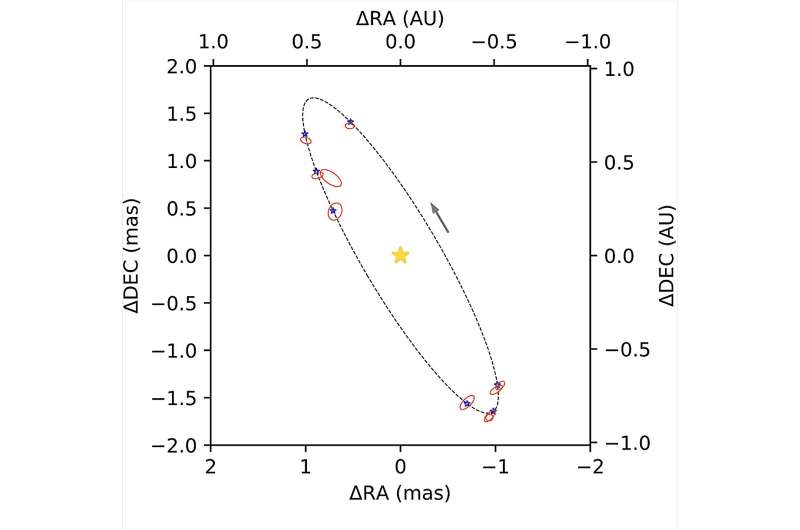Scientists working with the powerful telescopes at Georgia State’s Center for High Angular Resolution Astronomy (CHARA) Array have completed a survey of a group of stars suspected to have devoured most of the gas from orbiting companion stars. These sensitive measurements have directly detected the feeble glow of the cannibalized stars.
The new research, led by Postdoctoral Research Associate Robert Klement, is published in The Astrophysical Journal. The work identifies new orbits of stripped subdwarf stars that circle fast-spinning massive stars, leading to new understanding of the life trajectory of close binary stars.
Working with colleagues at the CHARA Array in Mount Wilson, Calif., Klement aimed the high-powered telescopes at a collection of relatively nearby B-emission line stars, or “Be stars” for short. These are rapidly rotating stars thought to harbor unusual orbiting companions.
The Be stars are probably formed in intense interactions between close pairs of stars. Astronomers find that many stars occur in such pairs, a trend that is especially true among stars more massive than our sun. Pairs with small separations face a tumultuous destiny because they grow in size as they age and can reach a dimension similar to their separation.
When this happens, gas from the growing star can cross the gap between the pair so that the companion can feast upon the transferred gas stream. This cannibalization process will eventually strip the mass donor star of almost all its gas and will leave behind the tiny hot core of its former nuclear-burning center.

Astronomers predicted that the mass transfer stream causes the companion star to spin up and become a very fast rotator. Some of the fastest rotating stars are found as Be stars. Be stars rotate so quickly that some of their gas is flung from their equatorial zones to form an orbiting gas ring.
Until now, this predicted stage in the life of close binary pairs has eluded astronomers because the stars’ separations are too small to see with conventional telescopes and because the stripped stellar corpses are hidden in the glare of their bright companions. However, Georgia State’s CHARA Array telescopes offered the researchers the means to find the stripped stars.
The CHARA Array uses six telescopes spread across the summit of Mount Wilson to act like an enormous single telescope that is 330 meters in diameter. This gives astronomers the ability to separate the light of pairs of stars even with very small angular offsets. Klement also used the MIRC-X and MYSTIC cameras—built at the University of Michigan and Exeter University in the U.K.—which can record the light signal of both very bright and very faint objects close together.
The researchers wanted to determine if the Be stars had been spun up by mass transfer and host orbiting stripped stars. Klement began a two-year observing program at CHARA, and his work quickly paid off. He discovered the faint light of stripped companions in nine of 37 Be stars. He focused on seven of these targets and was able to follow the orbital motion of the stellar corpse around the Be star.
“The orbits are important because they allow us to determine the masses of stellar pairs,” Klement said. “Our mass measurements indicate that stripped stars lost almost everything. In the case of the star HR2142, the stripped star probably went from 10 times the mass of the sun down to about one solar mass.”

Stripped stars were not detected around every Be star, and researchers believe that in some of these cases, the corpse has transformed into a tiny white dwarf star, too faint to detect even with the CHARA Array. In other cases, it may be that the interaction was so intense that the stars merged to become one fast-rotating star.
Klement is now extending the search for orbiting stripped stars to Be stars in the southern sky using the European Southern Observatory’s Very Large Telescope Interferometer in Chile.
He is also working with Luqian Wang at the Yunnan Observatories in China in research using the NASA Hubble Space Telescope to detect the faint light of the stripped companions. Because these corpses are hot, they are relatively brighter in the ultraviolet wavelengths that can only be observed with the Hubble Space Telescope.
“This survey of Be stars—and the discovery of nine faint companion stars—truly demonstrates the power of CHARA,” said Alison Peck, a program director in the National Science Foundation’s Astronomical Sciences Division, which supports the CHARA Array. “Using the array’s exceptional angular resolution and high dynamic range allows us to answer questions about star formation and evolution that have never been possible to answer before.”
Douglas Gies, director of the CHARA Array, said the research has finally uncovered a key hidden stage in the lives of close stellar pairs.
“The CHARA Array survey of the Be stars has revealed directly that these stars were created through a wholesale transformation by mass transfer,” Gies said. “We are now seeing, for the first time, the result of the stellar feast that led to the stripped stars.”
More information:
Robert Klement et al, The CHARA Array Interferometric Program on the Multiplicity of Classical Be Stars: New Detections and Orbits of Stripped Subdwarf Companions, The Astrophysical Journal (2024). DOI: 10.3847/1538-4357/ad13ec
Provided by
Georgia State University
Citation:
Learning the trick to finding cannibalized stars (2024, February 9)
retrieved 11 February 2024
from
This document is subject to copyright. Apart from any fair dealing for the purpose of private study or research, no
part may be reproduced without the written permission. The content is provided for information purposes only.